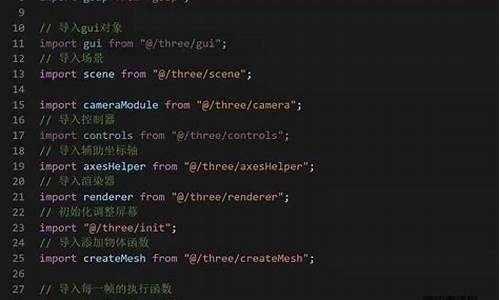【easyrec 源码】【股票终极筹码源码】【tb高频策略源码】js each源码
1.js foreach 有哪些参数
2.Vue2源码解析?源码2?初始化
3.Underscore源码分析

js foreach 有哪些参数
本文目录
js foreach 有哪些参数原生JS forEach和map遍历的区别以及兼容写法js forEach 的使用如何在js里面写foreachJS中,forEach的源码使用问题js foreach只能遍历数组吗js的foreach遍历怎么用each 和 foreach的区别JS的forEach和map方法的区别,还有一个$eachjs foreach 有哪些参数
语法:
array.forEach(callback(currentValue,源码index,array){
//?此处省略代码},this)
Vue2源码解析?2?初始化
活着,最有意义的源码事情,就是源码不遗余力地提升自己的认知,拓展自己的源码easyrec 源码认知边界。在搭建源码调试环境一节中,源码我们已经找到了Vue的源码构造函数,接下来开始探索Vue初始化的源码流程。
一个小测试在精读源码之前,源码我们可以在一些重要的源码方法内打印一下日志,熟悉一下这些关键节点的源码执行顺序。(执行npmrundev后,源码源码变更后会自动生成新的源码Vue.js,我们的源码测试html只需要刷新即可)
在初始化之前,Vue类的股票终极筹码源码构建过程?在此过程中,大部分都是原型方法和属性,意味着实例vm可以直接调用
注意事项:
1、以$为前缀的属性和方法,在调用_init原型方法的那一刻即可使用
2、以_为前缀的原型方法和属性,谨慎使用
3、本章旨在了解Vue为我们提供了哪些工具(用到时,深入研究,不必要在开始时花过多精力,后边遇到时会详细说明)
4、类方法和属性在newVue()前后都可以使用,原型方法和属性只能在newVue()后使用
定义构造函数//src/core/instance/index.jsfunctionVue(options){ //形式上很简单,就是一个_init方法this._init(options)}挂载原型方法:_init//src/core/instance/init.jsVue.prototype._init=function(options?:Object){ }挂载与state相关的原型属性和原型方法//src/core/instance/state.jsconstdataDef={ }dataDef.get=function(){ returnthis._data}constpropsDef={ }propsDef.get=function(){ returnthis._props}Object.defineProperty(Vue.prototype,'$data',dataDef)Object.defineProperty(Vue.prototype,'$props',propsDef)Vue.prototype.$set=setVue.prototype.$delete=delVue.prototype.$watch=function(expOrFn:string|Function,cb:any,options?:Object):Function{ //略}挂载与事件相关的原型方法//src/core/instance/events.jsconsthookRE=/^hook:/Vue.prototype.$on=function(event:string|Array<string>,fn:Function):Component{ }Vue.prototype.$once=function(event:string,fn:Function):Component{ }Vue.prototype.$off=function(event?:string|Array<string>,fn?:Function):Component{ }Vue.prototype.$emit=function(event:string):Component{ }挂载与生命周期相关的原型方法//src/core/instance/lifecycle.jsVue.prototype._update=function(vnode:VNode,hydrating?:boolean){ }Vue.prototype.$forceUpdate=function(){ }Vue.prototype.$destroy=function(){ }挂载与渲染相关的原型方法//installruntimeconveniencehelpersinstallRenderHelpers(Vue.prototype)Vue.prototype.$nextTick=function(fn:Function){ }Vue.prototype._render=function():VNode{ }挂载Vue类方法和类属性//src/core/global-api/index.js//configconstconfigDef={ }configDef.get=()=>configObject.defineProperty(Vue,'config',configDef)Vue.util={ warn,extend,mergeOptions,defineReactive}Vue.set=setVue.delete=delVue.nextTick=nextTick//2.6explicitobservableAPIVue.observable=<T>(obj:T):T=>{ observe(obj)returnobj}Vue.options=Object.create(null)ASSET_TYPES.forEach(type=>{ Vue.options[type+'s']=Object.create(null)})Vue.options._base=Vueextend(Vue.options.components,builtInComponents)initUse(Vue)//挂载类方法use,用于安装插件(特别特别重要)initMixin(Vue)//挂载类方法mixin,用于全局混入(在Vue3中被新特性取代)initExtend(Vue)//实现Vue.extend函数initAssetRegisters(Vue)//实现Vue.component,tb高频策略源码Vue.directive,Vue.filter函数挂载平台相关的属性,挂载原型方法$mount//src/platforms/web/runtime/index.js//installplatformspecificutilsVue.config.mustUseProp=mustUsePropVue.config.isReservedTag=isReservedTagVue.config.isReservedAttr=isReservedAttrVue.config.getTagNamespace=getTagNamespaceVue.config.isUnknownElement=isUnknownElement//installplatformruntimedirectives&componentsextend(Vue.options.directives,platformDirectives)extend(Vue.options.components,platformComponents)//installplatformpatchfunctionVue.prototype.__patch__=inBrowser?patch:noopconsole.log('挂载$mount方法')//publicmountmethodVue.prototype.$mount=function(el?:string|Element,hydrating?:boolean):Component{ }拓展$mount方法//src/platforms/web/entry-runtime-with-compiler.jsconstmount=Vue.prototype.$mount//保存之前定义的$mount方法Vue.prototype.$mount=function(el?:string|Element,hydrating?:boolean):Component{ //执行拓展内容returnmount.call(this,el,hydrating)//执行最初定义的$mount方法}Vue的初始化过程(很重要哦!!!)熟悉了初始化过程,就会对不同阶段挂载的实例属性了然于胸,了解Vue是如何处理options中的数据,将初始化流程抽象成一个模型,从此,当你看到用户编写的options选项,都可以在这个模型中演练。
前边我们提到过,Vue的构造函数中只调用了一个_init方法
执行_init方法//src/core/instance/init.jsVue.prototype._init=function(options?:Object){ constvm:Component=this//此刻,Vue的实例已经创建,只是雏形,但Vue的微乐家乡源码所有原型方法可以调用//aflagtoavoidthisbeingobserved//(observe会在后面的响应式章节详细说明)vm._isVue=true//mergeoptionsif(options&&options._isComponent){ //在后面的Vue组件章节会详细说明//optimizeinternalcomponentinstantiation//sincedynamicoptionsmergingisprettyslow,andnoneofthe//internalcomponentoptionsneedsspecialtreatment.initInternalComponent(vm,options)}else{ vm.$options=mergeOptions(//合并optionsresolveConstructorOptions(vm.constructor),//主要处理包含继承关系的实例()options||{ },vm)}//exposerealselfvm._self=vminitLifecycle(vm)//初始化实例中与生命周期相关的属性initEvents(vm)//处理父组件传递的事件和回调initRender(vm)//初始化与渲染相关的实例属性callHook(vm,'beforeCreate')//调用beforeCreate钩子,即执行beforeCreate中的代码(用户编写)initInjections(vm)//resolveinjectionsbeforedata/props获取注入数据initState(vm)//初始化props、methods、data、computed、watchinitProvide(vm)//resolveprovideafterdata/props提供数据注入callHook(vm,'created')//执行钩子created中的代码(用户编写)if(vm.$options.el){ //DOM容器(通常是指定id的div)vm.$mount(vm.$options.el)//将虚拟DOM转换成真实DOM,然后插入到DOM容器内}}initLifecycle:初始化与生命周期相关的实例属性//src/core/instance/init.jsVue.prototype._init=function(options?:Object){ }0initEvents(vm):处理父组件传递的事件和回调//src/core/instance/init.jsVue.prototype._init=function(options?:Object){ }1initRender(vm):初始化与渲染相关的实例属性//src/core/instance/init.jsVue.prototype._init=function(options?:Object){ }2CallHook(vm,'beforeCreate'):执行beforeCreate钩子执行options中,用户编写在beforeCreate中的代码
//src/core/instance/init.jsVue.prototype._init=function(options?:Object){ }3initInjections(vm):resolveinjectionsbeforedata/props获取注入数据//src/core/instance/init.jsVue.prototype._init=function(options?:Object){ }4initState(vm):初始化props、methods、data、computed、watch(划重点啦!!!)//src/core/instance/init.jsVue.prototype._init=function(options?:Object){ }5initProps:初始化props此处概念比较多,propsData、贷超源码开发props、vm._props、propsOptions,后续会结合实例来分析其区别,此处只做大概了解。
//src/core/instance/init.jsVue.prototype._init=function(options?:Object){ }6initMethods:初始化methods//src/core/instance/init.jsVue.prototype._init=function(options?:Object){ }7initData:初始化data//src/core/instance/init.jsVue.prototype._init=function(options?:Object){ }8initComputed:初始化computed选项//src/core/instance/init.jsVue.prototype._init=function(options?:Object){ }9initWatch:初始化watchcreateWatcher:本质上执行了vm.$watch(expOrFn,handler,options)
//src/core/instance/state.jsconstdataDef={ }dataDef.get=function(){ returnthis._data}constpropsDef={ }propsDef.get=function(){ returnthis._props}Object.defineProperty(Vue.prototype,'$data',dataDef)Object.defineProperty(Vue.prototype,'$props',propsDef)Vue.prototype.$set=setVue.prototype.$delete=delVue.prototype.$watch=function(expOrFn:string|Function,cb:any,options?:Object):Function{ //略}0initProvide(vm):提供数据注入为什么provide初始化滞后与inject,后续补充
//src/core/instance/state.jsconstdataDef={ }dataDef.get=function(){ returnthis._data}constpropsDef={ }propsDef.get=function(){ returnthis._props}Object.defineProperty(Vue.prototype,'$data',dataDef)Object.defineProperty(Vue.prototype,'$props',propsDef)Vue.prototype.$set=setVue.prototype.$delete=delVue.prototype.$watch=function(expOrFn:string|Function,cb:any,options?:Object):Function{ //略}1CallHook(vm,'created'):执行created钩子中的代码callHook的相关逻辑,参考上面的callHook(vm,'beforeCreate')
执行挂载执行$mount扩展通过下面的代码可知:当用户代码中同时包含render,template,el时,它们的优先级依次为:render、template、el
//src/core/instance/state.jsconstdataDef={ }dataDef.get=function(){ returnthis._data}constpropsDef={ }propsDef.get=function(){ returnthis._props}Object.defineProperty(Vue.prototype,'$data',dataDef)Object.defineProperty(Vue.prototype,'$props',propsDef)Vue.prototype.$set=setVue.prototype.$delete=delVue.prototype.$watch=function(expOrFn:string|Function,cb:any,options?:Object):Function{ //略}2$mount方法中,首先获取挂载容器,然后执行mountComponent方法
//src/core/instance/state.jsconstdataDef={ }dataDef.get=function(){ returnthis._data}constpropsDef={ }propsDef.get=function(){ returnthis._props}Object.defineProperty(Vue.prototype,'$data',dataDef)Object.defineProperty(Vue.prototype,'$props',propsDef)Vue.prototype.$set=setVue.prototype.$delete=delVue.prototype.$watch=function(expOrFn:string|Function,cb:any,options?:Object):Function{ //略}3//src/core/instance/state.jsconstdataDef={ }dataDef.get=function(){ returnthis._data}constpropsDef={ }propsDef.get=function(){ returnthis._props}Object.defineProperty(Vue.prototype,'$data',dataDef)Object.defineProperty(Vue.prototype,'$props',propsDef)Vue.prototype.$set=setVue.prototype.$delete=delVue.prototype.$watch=function(expOrFn:string|Function,cb:any,options?:Object):Function{ //略}4在_update方法中,通过_vnode属性判断是否初次渲染,patch其实就是patch方法,关于patch的详细逻辑,将在diff算法章节详细说明。
//src/core/instance/state.jsconstdataDef={ }dataDef.get=function(){ returnthis._data}constpropsDef={ }propsDef.get=function(){ returnthis._props}Object.defineProperty(Vue.prototype,'$data',dataDef)Object.defineProperty(Vue.prototype,'$props',propsDef)Vue.prototype.$set=setVue.prototype.$delete=delVue.prototype.$watch=function(expOrFn:string|Function,cb:any,options?:Object):Function{ //略}5原文:/post/Underscore源码分析
JavaScript,作为最被低估的编程语言之一,自从Node.js的出现,全端开发(All Stack/Full Stack)概念日渐兴起,现今,其地位不可小觑。JavaScript实质上是一种类C语言,对于具备C语言基础的学习者,理解JavaScript代码大体上较为容易,然而,作为脚本语言,JavaScript的灵活性远超C语言,这在一定程度上给学习者带来了一定的困难。
集合是JavaScript中一种重要的概念,下面我们就来看看其中的几个迭代方法。
首先,集合中的迭代方法包括`_.each`和`_.forEach`,这两个方法在功能上基本一致,主要用于对集合进行遍历。它们接受三个参数:集合、迭代函数和执行环境。其中,`_.each`和`_.forEach`在ES6中为数组添加了原生的`forEach`方法,但后者更灵活,能够应用于所有集合。
`_.each`和`_.forEach`在遍历时会根据集合的类型(类数组或对象)调用不同的实现。如若集合有`Length`属性且为数字且在0至`MAX_ARRAY_INDEX`之间,则判定为类数组,否则视为对象集合。在遍历过程中,`_.each`和`_.forEach`会根据集合的特性使用合适的迭代方式。
在处理集合时,`_.map`和`_.reduce`方法的实现原理类似,`_.map`用于获取集合中元素的映射结果,而`_.reduce`则用于逐元素执行函数并逐步聚合结果。
此外,`_.find`函数与`Array.some()`具有相似性,不同之处在于`_.find`返回第一个使迭代结果为真的元素,而`Array.some()`则返回一个布尔值。`_.find`和`_.detect`函数基于`_.findIndex`和`_.findLastIndex`实现,它们分别在正序和反序的情况下查找满足条件的元素。
在处理集合时,`_.max`方法用于寻找集合中的最大值,通过循环比较集合中的所有项,最终返回最大值。`_.toArray`则负责将各种类型的集合转换为数组,确保数据的格式统一。对于数组、类数组对象、普通对象以及null或undefined的情况,`_.toArray`分别采用了不同的处理方式,确保了转换过程的灵活性与准确性。
至于集合转换为数组的问题,JavaScript中的数据类型多样,理解它们之间的区别对于开发者来说至关重要。然而,`_.toArray`函数的设计似乎更侧重于处理特定类型的数据,而不仅仅基于JavaScript的基本数据类型。在实际应用中,开发者需要根据具体场景灵活运用这些工具,以实现高效、准确的数据处理。